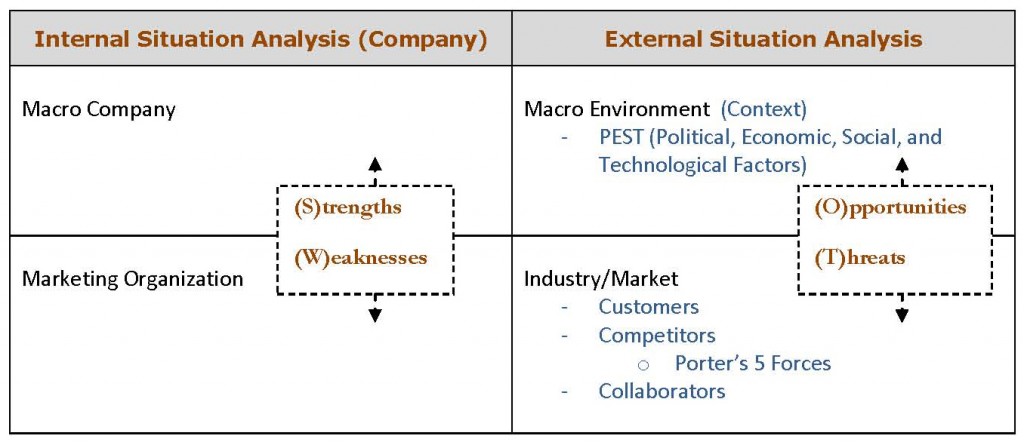A take on the interrelation between strategy frameworks
4/15/12 / Leo Lewis


Marketing managers and executives: What would you do if you were asked to take several of the most common strategy tools and organize them to show how they interrelate for marketing planning and strategic decision making? (No peeking below!) The tools and frameworks to be considered, in no particular order, are: PEST, SWOT, the “5 Cs” (Customer, Competitor, Company, Collaborators, and Context), Porter’s 5 Forces Industry Analysis, External Situation Analysis, and Internal Situation Analysis.
At this point, you may be saying, “Stop already, stop! All of these strategy tools get thrown at us all of the time and it’s hard to know how they interrelate in the big picture! It’s difficult to understand how to make the resulting analysis actionable. What am I supposed to DO with it?”
We first propose the following table to make some sense and order out of these six frameworks or tools. (All variables from frameworks above are in blue). We start at the very top level by dividing out Internal and External Situation analyses. Then, we do a little of our own categorization within each of these and break out “macro” and “micro” components.

Now, we can add in all of our variables from the strategic frameworks. For the 5 Cs, the “C” for “Company” becomes one in the same with Internal Situation Analysis. The “C” for “Context” becomes one in the same with the Macro Environment section of the External Situation Analysis. PEST is then listed as an environmental scanning tool within the Macro Environment/External Situation Analysis. Our other three “Cs” all fall under the Industry/Market section of the External Situation Analysis. Each of these is naturally dependent on at least some definition or parameters of the market you’re playing in.
Finally we’d be remiss if we didn’t address the SWOT variables. First off, we recognize that SW and OT are sometimes described as being outputs of Internal and External Situation Analyses, respectively. We choose to consider these as lying within these Analyses. A comprehensive situation analysis will naturally uncover strengths and weaknesses on the Internal Situation (see our prior post on Marketing Audit for the Marketing Organization as one reason why) and an External Situation Analysis (through tools such as PEST, Porter’s 5 Forces, etc) will uncover threats. And while opportunities will also certainly be uncovered, we like to think of opportunities separately as a big part of the next step in marketing planning and strategy.
This leads us to summarize with what to DO with the output from the analysis framework above. We think a major output from holistic analyses will be Opportunities that are revealed. Strategic variables, such as “business strength” (from internal) and “market attractiveness” (from external) allow for further analysis such as that through the GE-McKinsey framework (as discussed in my prior blog post) and other frameworks for strategic decision making that show the importance of the intersection of our now-defined and well-understood components of Company, Customer, and Competitors. Clarity around these allows marketing goals to be logically established.
To learn more about how Corona Insights’ can assist you with your strategic marketing visit our Insights for Strategic Marketing page or contact us.